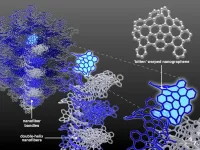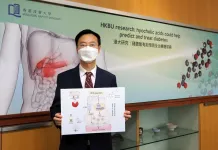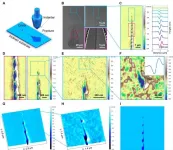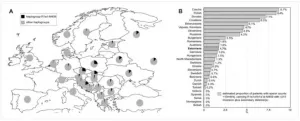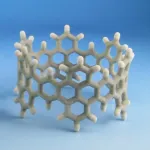(Press-News.org) Nanographene is flexible, yet stronger than steel. With unique physical and electronic properties, the material consists of carbon molecules only one atom thick arranged in a honeycomb shape. Still early in technological development, current fabrication methods require the addition of substituents to obtain a uniform material. Additive-free methods result in flimsy, breakable fibers--until now.
An international team of researchers has developed self-assembling, stable and strong nanographene wires. The results were published on March 24 in Journal of the American Chemical Society.
The team, led by Yasutomo Segawa, associate professor at the Institute for Molecular Science, part of the National Institutes of Natural Science in Japan, set out to synthesize curved, infinitely stacking nanographenes -- like potato chips in a cardboard can -- that can assemble into nanowires.
"Effectively stacked hydrocarbon wires have the potential to be used as a variety of nano-semiconductor materials," Segawa said. "Previously, it has been necessary to introduce substituents that are not related to or inhibit the desired electronic function in order to control the assembly of the wires."
By removing substituents, or additives, from the fabrication process, researchers can develop molecular materials that have a specific, desired electronic function, according to Segawa. With this goal in mind, the team developed a molecule called 'bitten' warped nanographene (bWNG), with 68 carbon atoms and 28 hydrogen atoms forming a 'bitten apple' shape. Created as a solution, when left to evaporate over 24 hours in the presence of hexane -- an ingredient in gasoline with six carbon atoms -- bWNG becomes a gel.
The researchers attempted to recrystallize the molecules of the original solution to examine the specific structure of the bWNG gel through X-ray crystallography. This technique can reveal the atomic and molecular structure of a crystal by irradiating the structure with X-rays and observing how they diffract.
"We attempted recrystallizing many times to determine the structure, but it grew to only a few hundred nanometers," Segawa said, noting that this size is much too small for X-ray crystallography. "It was only by electron diffraction, a new method for determining the structure of organic materials, that we were able to analyze the structure."
Electron diffraction is similar to X-ray crystallography, but it uses electrons instead of X-rays, resulting in a pattern of interference with the sample material that indicates the internal structure.
They found that the bWNG gel consisted of double-stranded, double-helix nanofibers that assembled themselves from curved, stackable nanographenes.
"The structure of the nanofibers is a double-stranded double helix, which is very stable and, therefore, strong," Segawa said. "Next, we would like to realize a semiconductor wire made entirely of carbon atoms."
INFORMATION:
Co-authors include Kenta Kato, Nobuhiko Mitoma, Taishi Nishihara, Yuh Hijikata and Kenichiro Itami, along with Segawa, with the Graduate School of Science, Nagoya University; Kiyofumi Takaba, Saori Maki-Yonekura and Koji Yonekura, Biostructural Mechanism Laboratory, RIKEN; Yusuke Nakanishi, Graduate School of Science, Tokyo Metropolitan University; Taito Hatakeyama and Takuma Kawada, Central Research Laboratory Technology and Development Division, Kanto Chemical Co., Inc.; and Lawrence T. Scott, Department of Chemistry, University of Nevada. Segawa, Mitoma, Nishihara and Itami are also affiliated with the Itami Molecular Nanocarbon Project at Nagoya University. Nishihara is also affiliated with the Institute of Advanced Energy at Kyoto University. Mitoma is also affiliated with the RIKEN Center for Emergent Matter Science. Hijikata, along with Itami, is also affiliated with the Institute of Transformative Bio-Molecules at Nagoya University with co-author Jenny Pirillo. Hijikata and Pirillo are also affiliated with the Institute for Chemical Reaction Design and Discovery at Hokkaido University. Yonekura is also affiliated with the Advanced Electron Microscope Development Unit, RIKEN-JEOL Collaboration Center and Institute of Multidisciplinary Research for Advanced Materials, Tohoku University. Segawa is also affiliated with the Department of Structural Molecular Science, The Graduate University for Advanced Studies.
The Japan Science and Technology Agency, the Ministry of Education, Culture, Sports, Science and Technology, the Japan Society for the Promotion of Science, the Toyoaki Scholarship Foundation, the Daiko Foundation and the United State National Science Foundation funded this work.
A series of studies led by researchers from Hong Kong Baptist University (HKBU) have revealed that hyocholic acid and its derivatives (collectively known as HCAs), a component of bile acids that facilitate fat digestion, are a promising risk indicator of type 2 diabetes. The strong efficacy of HCAs in regulating blood glucose levels and protecting against diabetes has also been uncovered. The findings open a window for the development of HCA-based predictive markers as well as anti-diabetic drugs.
The research results have been published in the international scientific journals ...
Autistic adults can be wrongly perceived as deceptive and lacking credibility, Flinders University researchers say, with this working against many caught in the legal system.
Ahead of World Autism Awareness Day (2 April 2021), a new paper in the Journal of Autism and Developmental Disorders asked 1,410 civilians to respond to video recordings with 30 adults with Autism Spectrum Disorder (ASD) and 29 non-ASD individuals to examine whether stereotypical behaviors associated with autism influenced people's perceptions of the individual.
Common behaviors include gaze aversion, repetitive body movements, literal interpretations of figurative language ...
Multilingual people have trained their brains to learn languages, making it easier to acquire more new languages after mastering a second or third. In addition to demystifying the seemingly herculean genius of multilinguals, researchers say these results provide some of the first neuroscientific evidence that language skills are additive, a theory known as the cumulative?enhancement model of language acquisition.
"The traditional idea is, if you understand bilinguals, you can use those same details to understand multilinguals. We rigorously checked that possibility with this research and saw multilinguals' language ...
Glassy materials play an integral role in the modern world, but inherent brittleness has long been the Achilles' heel that severely limits their usefulness. Due to the disordered amorphous structure of glassy materials, many mysteries remain. These include the fracture mechanisms of traditional glasses, such as silicate glasses, as well as the origin of the intriguing patterned fracture morphologies of metallic glasses.
Cavitation has been widely assumed to be the underlying mechanism governing the fracture of metallic glasses, as well as other glassy systems. Up until now, however, scientists have been unable to directly observe the cavitation behavior of fractures, despite their intensive ...
The findings published in eLife show that men with this unstable subtype of the Y chromosome have a significantly increased risk of genomic rearrangements. These rearrangements affect the sperm production process (spermatogenesis) and consequently, these men can be up to nine times more likely to have fertility issues. Molecular diagnostics of this genetic variant could help identify those at higher risk in their early adulthood, giving them the chance to make decisions about future family planning early on. Currently, the exact cause of infertility ...
Infants born by cesarean section have a relatively meager array of bacteria in the gut. But by the age of three to five years they are broadly in line with their peers. This is shown by a study that also shows that it takes a remarkably long time for the mature intestinal microbiota to get established.
Fredrik Bäckhed, Professor of Molecular Medicine at Sahlgrenska Academy, University of Gothenburg, has been heading this research. The study, conducted in collaboration with Halland County Hospital in Halmstad, is now published in the journal Cell Host & Microbe.
Professor Bäckhed and his group have previously demonstrated that the composition of children's intestinal microbiota is affected by their mode of delivery and ...
The current method of manufacturing carbon nanotubes--in essence rolled up sheets of graphene--is unable to allow complete control over their diameter, length and type. This problem has recently been solved for two of the three different types of nanotubes, but the third type, known as 'zigzag' nanotubes, had remained out of reach. Researchers with Japan's National Institutes of Natural Sciences (NINS) have now figured out how to synthesize the zigzag variety.
Their method is described in the journal Nature Chemistry, published on January 25.
Thanks to carbon's unique capacity to combine ...
Although beef is one of the most consumed foods around the world, eating it when it's past its prime is not only unsavory, but also poses some serious health risks. Unfortunately, available methods to check for beef freshness have various disadvantages that keep them from being useful to the public. For example, chemical analysis or microbial population evaluations take too much time and require the skills of a professional. On the other hand, non-destructive approaches based on near-infrared spectroscopy require expensive and sophisticated equipment. Could artificial intelligence be the key to a more cost-effective way to assess the freshness of beef?
At Gwangju Institute of Science and Technology (GIST), Korea, a team of scientists led by Associate Processors Kyoobin Lee and ...
A study by KAIST researchers revealed that an ionized gas jet blowing onto water, also known as a 'plasma jet', produces a more stable interaction with the water's surface compared to a neutral gas jet. This finding reported in the April 1 issue of Nature will help improve the scientific understanding of plasma-liquid interactions and their practical applications in a wide range of industrial fields in which fluid control technology is used, including biomedical engineering, chemical production, and agriculture and food engineering.
Gas jets can create dimple-like depressions in liquid surfaces, and this phenomenon is familiar to anyone who has seen the cavity produced by blowing air through a straw ...
How do our facial expressions in response to seeing others in pain influence how we see and feel their pain? There are many situations where it may be helpful to suppress our emotional responses to the pain of others. For example, doctors are trained to regulate their emotional responses to the pain of their patients, which may help them to avoid exhausting their own cognitive and emotional resources. Understanding whether suppressing our own facial expressions in response to other's pain reduces our ability to empathize with them has important implications for a variety ...
